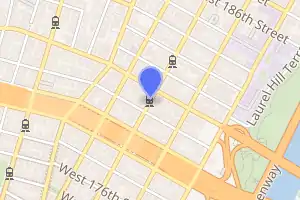181st Street station (IRT Broadway–Seventh Avenue Line)
181st Street is a temporarily closed station on the IRT Broadway–Seventh Avenue Line of the New York City Subway. Located at the intersection of St. Nicholas Avenue and 181st Street in Washington Heights, Manhattan, it is typically served by the 1 train at all times.
181 Street | ||||||||||||||||||||||||||||||||||||||||||||||||||||||||||||||||||||
|---|---|---|---|---|---|---|---|---|---|---|---|---|---|---|---|---|---|---|---|---|---|---|---|---|---|---|---|---|---|---|---|---|---|---|---|---|---|---|---|---|---|---|---|---|---|---|---|---|---|---|---|---|---|---|---|---|---|---|---|---|---|---|---|---|---|---|---|---|
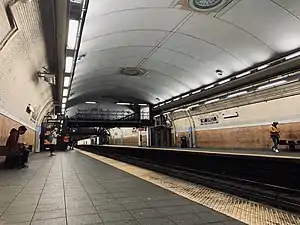 Renovated platform view | ||||||||||||||||||||||||||||||||||||||||||||||||||||||||||||||||||||
| Station statistics | ||||||||||||||||||||||||||||||||||||||||||||||||||||||||||||||||||||
| Address | West 181st Street & Saint Nicholas Avenue New York, NY 10033 | |||||||||||||||||||||||||||||||||||||||||||||||||||||||||||||||||||
| Borough | Manhattan | |||||||||||||||||||||||||||||||||||||||||||||||||||||||||||||||||||
| Locale | Washington Heights | |||||||||||||||||||||||||||||||||||||||||||||||||||||||||||||||||||
| Coordinates | 40.849°N 73.934°W | |||||||||||||||||||||||||||||||||||||||||||||||||||||||||||||||||||
| Division | A (IRT) | |||||||||||||||||||||||||||||||||||||||||||||||||||||||||||||||||||
| Line | IRT Broadway–Seventh Avenue Line | |||||||||||||||||||||||||||||||||||||||||||||||||||||||||||||||||||
| Services | 1 | |||||||||||||||||||||||||||||||||||||||||||||||||||||||||||||||||||
| Transit | ||||||||||||||||||||||||||||||||||||||||||||||||||||||||||||||||||||
| Structure | Underground | |||||||||||||||||||||||||||||||||||||||||||||||||||||||||||||||||||
| Depth | 120 feet (37 m) | |||||||||||||||||||||||||||||||||||||||||||||||||||||||||||||||||||
| Platforms | 2 side platforms | |||||||||||||||||||||||||||||||||||||||||||||||||||||||||||||||||||
| Tracks | 2 | |||||||||||||||||||||||||||||||||||||||||||||||||||||||||||||||||||
| Other information | ||||||||||||||||||||||||||||||||||||||||||||||||||||||||||||||||||||
| Opened | May 30, 1906 | |||||||||||||||||||||||||||||||||||||||||||||||||||||||||||||||||||
| Closed | December 5, 2020 | |||||||||||||||||||||||||||||||||||||||||||||||||||||||||||||||||||
| Station code | 301[1] | |||||||||||||||||||||||||||||||||||||||||||||||||||||||||||||||||||
| Accessible | ||||||||||||||||||||||||||||||||||||||||||||||||||||||||||||||||||||
| Opposite- direction transfer | Yes | |||||||||||||||||||||||||||||||||||||||||||||||||||||||||||||||||||
| Traffic | ||||||||||||||||||||||||||||||||||||||||||||||||||||||||||||||||||||
| 2019 | 3,523,536[2] | |||||||||||||||||||||||||||||||||||||||||||||||||||||||||||||||||||
| Rank | 143 out of 424[2] | |||||||||||||||||||||||||||||||||||||||||||||||||||||||||||||||||||
| Station succession | ||||||||||||||||||||||||||||||||||||||||||||||||||||||||||||||||||||
| Next north | no service due to renovations 191st Street: 1 | |||||||||||||||||||||||||||||||||||||||||||||||||||||||||||||||||||
| Next south | no service due to renovations 168th Street: 1 | |||||||||||||||||||||||||||||||||||||||||||||||||||||||||||||||||||
| ||||||||||||||||||||||||||||||||||||||||||||||||||||||||||||||||||||
| ||||||||||||||||||||||||||||||||||||||||||||||||||||||||||||||||||||
| ||||||||||||||||||||||||||||||||||||||||||||||||||||||||||||||||||||
| ||||||||||||||||||||||||||||||||||||||||||||||||||||||||||||||||||||
181st Street Subway Station (IRT) | ||||||||||||||||||||||||||||||||||||||||||||||||||||||||||||||||||||
| MPS | New York City Subway System MPS | |||||||||||||||||||||||||||||||||||||||||||||||||||||||||||||||||||
| NRHP reference No. | 05000224[3] | |||||||||||||||||||||||||||||||||||||||||||||||||||||||||||||||||||
| Added to NRHP | March 30, 2005 | |||||||||||||||||||||||||||||||||||||||||||||||||||||||||||||||||||
Built by the Interborough Rapid Transit Company (IRT), the station opened on May 30, 1906, as part of the first subway, although the line had opened two months earlier and trains were skipping the station. Due to the station's depth, the tunnel was blasted through the hillside; during the station's construction, a 300-ton boulder had killed 10 miners. The station's platforms were lengthened in 1948. The station is closed from December 2020 to December 2021 for elevator replacement.
The 181st Street station contains two side platforms and two tracks. The station was built with tile and mosaic decorations as well as a ceiling vault. The platforms contain exits to 181st Street and Broadway; the only access to and from the station is via a set of four elevators, though the station is not ADA-accessible. The station is listed on the National Register of Historic Places.
History
Construction and opening
Planning for the city's first subway line dates to the Rapid Transit Act, authorized by the New York State Legislature in 1894.[4]:139–140 The subway plans were drawn up by a team of engineers led by William Barclay Parsons, chief engineer of the Rapid Transit Commission. It called for a subway line from New York City Hall in lower Manhattan to the Upper West Side, where two branches would lead north into the Bronx.[5]:3 A plan was formally adopted in 1897, and legal challenges were resolved near the end of 1899.[4]:148 The Rapid Transit Construction Company, organized by John B. McDonald and funded by August Belmont Jr., signed Contract 1 with the Rapid Transit Commission in February 1900,[6] in which it would construct the subway and maintain a 50-year operating lease from the opening of the line.[4]:182 In 1901, the firm of Heins & LaFarge was hired to design the underground stations.[5]:4 Belmont incorporated the Interborough Rapid Transit Company (IRT) in April 1902 to operate the subway.[4]:182
The 181st Street station was constructed as part of the IRT's West Side Line (now the Broadway–Seventh Avenue Line) from 133rd Street to a point 100 feet (30 m) north of 182nd Street. Work on this section was conducted by L. B. McCabe & Brother, who started building the tunnel segment on May 14, 1900.[6] The 168th Street, 181st Street, and 191st Street stations were built as part of the Washington Heights Mine Tunnel (also known as the Fort George Tunnel), which stretches for over 2 miles (3.2 km).[3]:5[7]:257 The tunnel was dug through the hard rock under Washington Heights, with work proceeding from either end as well as from construction shafts. Construction shafts were excavated at 168th and 181st Streets, and elevators were installed inside these construction shafts after the tunnel was completed.[7]:257[8]:60 Due to the steep terrain, the tunnel had to be mined using explosives, and blasting was done at in the early morning to minimize disruption. Much of the rock was crushed for concrete, including the concrete floor. The rails and arched roof were laid using travelers that proceeded the length of the tunnel.[3]:5 During construction, on October 24, 1903, a 300-ton boulder weakened by an explosive gave way, killing 10 miners (six instantly) and injuring eight more.[9][10] The dead miners consisted of eight Italian immigrants, the foreman from Italy, and an electrician from Germany.[11]
The original New York City Subway line from City Hall to 145th Street on the West Side Branch opened in 1904,[4]:186[12]:189 with the line being extended to 157th Street that year.[13]:191 The West Side Branch was extended northward from 157th Street to a temporary terminus at 221st Street and Broadway on March 12, 1906, with the station at 181st Street not yet open.[14] This extension was served by shuttle trains operating between 157th Street and 221st Street for two months. The 181st Street station opened on May 30, 1906, when express trains began running through to 221st Street.[15] The opening of the first subway line, and particularly the 181st Street station, helped contribute to the development of Washington Heights.[3]:10 After the initial system was completed in 1908,[16] the station was served by West Side local and express trains. Express trains began at South Ferry in Manhattan or Atlantic Avenue in Brooklyn, and ended at 242nd Street in the Bronx. Local trains ran from City Hall to 242nd Street during rush hours, continuing south from City Hall to South Ferry at other times.[17] In 1918, the Broadway–Seventh Avenue Line opened south of Times Square–42nd Street, thereby dividing the original line into an "H" system. Local trains were sent to South Ferry, while express trains used the new Clark Street Tunnel to Brooklyn.[18]
20th century
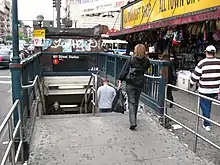
The station was originally built with two elevators on the southern end of the uptown platform.[19] In fiscal year 1909, work was done to increase the carrying load of the elevators.[20] On June 25, 1909, the New York City Board of Estimate approved an appropriation of $160,000 for the installation of four additional elevators on the northern end of the uptown platform.[21] These elevators measured 8.75 by 11.5 feet (2.67 by 3.51 m) each and could carry up to 8,000 pounds (3,628.7 kg).[22] In June 1910, work on the additional elevators was about 50 percent complete, and was on track to be completed by March 1, 1911, with their in service date to be earlier than that.[23] Work to install the elevators was nearly complete in 1911, and the final finishes were installed by January and February 1912.[24]
In 1909, to address overcrowding, the New York Public Service Commission proposed lengthening platforms at stations along the original IRT subway.[25]:168 On January 18, 1910, a modification was made to Contracts 1 and 2 to lengthen station platforms to accommodate ten-car express and six-car local trains. In addition to $1.5 million (equivalent to $41.2 million in 2019) spent on platform lengthening, $500,000 (equivalent to $13,719,643 in 2019) was spent on building additional entrances and exits. It was anticipated that these improvements would increase capacity by 25 percent.[26]:15 The northbound platform at the 181st Street station was extended 176 feet (54 m) to the north; timbering was used to support the arched ceiling during the extension work, thereby allowing it to retain structural integrity.[26]:113–114 The southbound platform was not lengthened.[26]:106 On January 24, 1911, ten-car express trains began running on the West Side Line.[25]:168[27]
In 1948, platforms on the IRT Broadway–Seventh Avenue Line from 103rd Street to 238th Street were lengthened to 514 feet (157 m) to allow full ten-car express trains to stop at this station. Previously, the station could accommodate six-car local trains, but ten-car trains could not open some of their doors. The platform extensions at these stations were opened in stages. On April 6, 1948, the platform extension at 181st Street opened.[28][29] Simultaneously, the IRT routes were given numbered designations with the introduction of "R-type" rolling stock. The first such fleet, the R12, was put into service in 1948.[30] The Broadway/West Side route to 242nd Street became known as the 1.[31] In 1959, all 1 trains became local.[32]
On December 28, 1950, the New York City Board of Transportation issued a report concerning the construction of bomb shelters in the subway system. Five deep stations in Washington Heights, including the 181st Street station, were considered to be ideal for being used as bomb-proof shelters. The program was expected to cost $104 million. These shelters were expected to provide limited protection against conventional bombs, while providing protection against shock waves and air blast, as well as from the heat and radiation from an atomic bomb. To become suitable as shelters, the stations would require water-supply facilities, first-aid rooms, and additional bathrooms.[33] However, the program, which required federal funding, was never completed.[34]
In Fiscal Year 1959, two elevators in the station were replaced with automatic ones that could travel at higher speeds.[35] The southern elevators were closed circa 1981.[3]:8 In Fiscal Year 1961, the installation of fluorescent lighting at the station was completed.[36]
In April 1988,[37] the New York City Transit Authority (NYCTA) unveiled plans to speed up service on the Broadway–Seventh Avenue Line through the implementation of a skip-stop service: the 9 train.[38] When skip-stop service started in 1989, it was only implemented north of 137th Street–City College on weekdays, and 181st Street was served by both the 1 and the 9.[39][40][41] Skip-stop service ended on May 27, 2005.[42][43]
The station was closed for the installation of new elevators in the late 1990s and reopened on November 22, 1999, upon the completion of elevator installation. The entrance at the southeast corner of 181st Street and St. Nicholas Avenue remained closed until early 2000.[44]
21st century
In 2004, the number of elevator attendants at the station and four others in Washington Heights was reduced to one per station as a result of budget cuts by the Metropolitan Transportation Authority (MTA). The agency had intended to remove all the attendants, but kept one in each station after many riders protested. The change saved $1.2 million a year.[45] In November 2007, the MTA proposed savings cuts to help reduce the agency's deficit. As part of the plan, all elevator operators at 181st Street, along with those in four other stations in Washington Heights, would have been cut.[46] On December 7, 2007, the MTA announced that it would not remove the remaining elevator operators at these stations. The move was intended to save $1.7 million a year, but was not implemented due to pushback from elected officials and residents from the area.[47] In October 2018, the MTA again proposed removing the elevator operators at the five stations, but this decision was reversed after dissent from the Transport Workers' Union.[48]
The elevator attendants serve as a way to reassure passengers as the elevators are the only entrance to the platforms, and passengers often wait for the elevators with an attendant.[49] The attendants at the five stations are primarily maintenance and cleaning workers who suffered injuries that made it hard for them to continue doing their original jobs.[50]
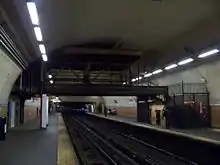
There was a partial ceiling collapse at the station in 2007.[9] After that collapse, protective scaffolding was erected, and officials devised a master plan for ceiling repairs. However, funds for the ceiling repairs were not approved by the New York State Legislature until August 14, 2009.[51] Two days later, on August 16 at around 10:30 pm, a 25-foot section of the bricks collapsed onto both tracks and platforms. Nobody was injured in the incident.[9] This caused suspension of 1 service between 168th Street and Dyckman Street stations in both directions for eight days with free shuttle buses providing replacement.[52][53] End-to-end service on the 1 was restored on August 24,[53] and the 181st Street station reopened one week later.[54][55] An internal MTA audit found that the ceiling had been allowed to decay for a decade prior to the collapse.[56] A $30 million repair of the 168th and 181st Street stations was to start in early 2012,[57][58] but was delayed by several months due to scheduling conflicts.[59] The renovation was scheduled to take two and a half years.[60]
This station is closed from December 5, 2020, to December 2021 for elevator repair, accelerated from the original date of March 2021 to February 2022.[61] It is unclear whether the elevator operators will keep their jobs after their replacement.[62][63] As part of the reconstruction, the elevators will also stop on the northbound platform at the station.[61] During construction, M3 bus service between 191st and 168th Streets was increased.[61]
Station layout
| G | Street level | Exit/entrance Elevators in mezzanine. Note: Platforms and street level are not accessible |
| M | Mezzanine | Fare control, station agent, elevator bank |
| Bridge | Bridge | Elevator bank, crossover to southbound platform |
| P Platform level |
Elevator bank | |
| Side platform | ||
| Northbound | ← | |
| Southbound | | |
| Side platform | ||
The 181st Street station has two tracks and two side platforms,[64][3]:3 and is served by the 1 train at all times.[65] It is a deep-level station 120 feet (37 m) below the surface.[3]:6 The 181st Street station is one of three stations in the New York City Subway system that can be accessed solely by elevators. The other two, also located on the Broadway–Seventh Avenue Line, are 168th Street one stop to the south, as well as Clark Street on the 2 and 3 trains in Brooklyn. However, this station is not ADA-accessible.[66] The station was added to the National Register of Historic Places in 2005.[3]
Near the northern end of the station, there are four elevators adjacent to the northbound platform, which lead from the fare control level to one level above the platforms. On this level, a footbridge connects the side platforms.[3]:6 There is a second footbridge near the center of the station. It leads to a shaft next to the northbound platform, which formerly contained two elevators leading to the fare control area. The footbridge and southern elevator bank was closed in 1981; the shaft is used only as an emergency exit, and contains a staircase.[3]:6
Design
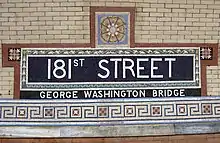
Much of the station is contained within a vault that measures 50 feet (15 m) wide.[8]:60 The lowest 6 feet (1.8 m) of the vault walls are wainscoted with rust-colored brick. Atop the brick wainscoting are a belt course made of marble and a multicolored mosaic frieze measuring about 16 inches (410 mm) thick. The tops of the walls contain tan brick. Tile name tablets are placed above the frieze at regular intervals, with white letters on a dark background surrounded by floral designs. Some of these plaques consist of a single mosaic tablet with the words "181st Street / George Washington Bridge" on two lines of text, in reference to the nearby George Washington Bridge. Others contain a primary plaque with the words "181st Street", a secondary plaque with the words "George Washington Bridge" beneath it, and a mosaic flower atop the primary plaque.[3]:6–7
The top of the vault ceiling is approximately three stories above the platform level. The center of the vault ceiling has six multicolored terracotta medallions at regular intervals; these formerly held lighting fixtures. The medallions contain foliate rings surrounded by egg-and-dart moldings, followed by guilloche moldings. Similar, smaller rosettes are on the side walls of the vault. The modern lighting fixtures are fluorescent tubes on the vault walls.[3]:6–7
The station's platform extensions have ceilings that are 10 to 12 feet (3.0 to 3.7 m) above the platform level. At the portals between the original vault and the much lower ceilings of the platform extensions, there is a wide arch over the tracks flanked by narrow arches over each platform. These transitions are clad with tan brick. The arch over the tracks has a volute with a laurel wreath.[3]:6 The walls of the platform extensions have white ceramic tiles with mosaic friezes as well as plaques with the words "181st Street / George Washington Bridge". The walls are divided every 15 feet (4.6 m) by multicolored tile pilasters that are 16 inches (410 mm) wide. Columns near the platform edge, clad with white tile, support the jack-arched concrete station roof.[3]:7
The northern elevator mezzanine is the only one that is open to the public, as the southern mezzanine was shuttered in 1981 when that elevator bank closed. The walls of the mezzanine and connecting passageways are clad with white ceramic tiles, while the tops of the walls contain multicolored friezes similar to at platform level. The mezzanine and passageway ceilings are made of concrete. The fare control area contains two retail spaces and is clad with ceramic and glazed tile.[3]:8
Exits
There are two exits to this station, one at either eastern corner of St. Nicholas Avenue and 181st Street. The northeast-corner entrance is inside a building and the southeast-corner entrance is on the street.[3]:8[67] The station serves Yeshiva University and the George Washington Bridge Bus Terminal.[67]
References
- "Station Developers' Information". Metropolitan Transportation Authority. Retrieved June 13, 2017.
- "Facts and Figures: Annual Subway Ridership 2014–2019". Metropolitan Transportation Authority. 2020. Retrieved May 26, 2020.
- "181st Street Subway Station (IRT)" (PDF). National Register of Historic Places, National Park Service. March 30, 2005. Retrieved September 11, 2020.
- Walker, James Blaine (1918). Fifty Years of Rapid Transit — 1864 to 1917. New York, N.Y.: Law Printing. Retrieved November 6, 2016.
- "Interborough Rapid Transit System, Underground Interior" (PDF). New York City Landmarks Preservation Commission. October 23, 1979. Retrieved November 19, 2019.
- Report of the Board of Rapid Transit Railroad Commissioners for the City of New York For The Year Ending December 31, 1904 Accompanied By Reports of the Chief Engineer and of the Auditor. Board of Rapid Transit Railroad Commissioners. 1905. pp. 229–236.
- Scott, Charles (1978). "Design and Construction of the IRT: Civil Engineering" (PDF). Historic American Engineering Record. pp. 208–282 (PDF pp. 209–283). Retrieved December 20, 2020.
 This article incorporates text from this source, which is in the public domain.
This article incorporates text from this source, which is in the public domain. - Interborough Rapid Transit Company (1904). New York Subway: Its Construction and Equipment. Interborough Rapid Transit Company.
 This article incorporates text from this source, which is in the public domain.
This article incorporates text from this source, which is in the public domain. - Dwyer, Jim (August 18, 2009). "Subway Station Ceilings Were Built to Last, but Not Forever". The New York Times. Archived from the original on December 8, 2019. Retrieved July 16, 2016.
- Roess, R.P.; Sansone, G. (2012). The Wheels That Drove New York: A History of the New York City Transit System. Springer Tracts on Transportation and Traffic. Springer Berlin Heidelberg. p. 166. ISBN 978-3-642-30484-2. Retrieved July 16, 2016.
- Mannes, Elena. "New York Underground Transcript". PBS. Archived from the original on May 6, 2016. Retrieved July 16, 2016.
- Report of the Public Service Commission For The First District of the State of New York For The Year Ending December 31, 1909. Albany: Public Service Commission. 1910.
- Report of the Public Service Commission For The First District of the State of New York For The Year Ending December 31, 1909. Albany: Public Service Commission. 1910.
- "Trains To Ship Canal — But They Whiz by Washington Heights Stations" (PDF). The New York Times. March 13, 1906. p. 16. ISSN 0362-4331. Retrieved August 16, 2015.
- "Express to 221st Street: Will Run In the Subway To-day–New 181st Street Station Ready" (PDF). The New York Times. May 30, 1906. ISSN 0362-4331. Retrieved September 1, 2016.
- "Our First Subway Completed At Last — Opening of the Van Cortlandt Extension Finishes System Begun in 1900 — The Job Cost $60,000,000 — A Twenty-Mile Ride from Brooklyn to 242d Street for a Nickel Is Possible Now". The New York Times. August 2, 1908. p. 10. Retrieved November 6, 2016.
- Brooklyn Daily Eagle Almanac. Brooklyn Daily Eagle. 1916. p. 119.
- "Open New Subway Lines to Traffic; Called a Triumph" (PDF). The New York Times. August 2, 1918. p. 1. ISSN 0362-4331. Retrieved October 4, 2011.
- "More Lifts for 181st St. Subway Station". The New York Times. April 23, 1909. Retrieved July 16, 2016.
- 1908-1909 Annual Report of the Interborough Rapid Transit Company for the Year Ended June 30, 1909. Interborough Rapid Transit Company. 1909. p. 9.
- "$160,000 For Subway Elevators" (PDF). The Evening Post. June 26, 1909. Retrieved February 12, 2019.
- "The Elevator and Escalator Equipment of the New York Subway". The Engineering record, building record and the sanitary engineer. 56: 69–70. 1907. Retrieved December 23, 2020 – via HathiTrust.
- 1909-1910 Annual Report of the Interborough Rapid Transit Company for the Year Ended June 30, 1910. Interborough Rapid Transit Company. 1910. p. 18.
- District, New York (State) Public Service Commission First (1913). Report of the Public Service Commission for the First District of the State of New York. The Commission. p. 163.
- Hood, Clifton (1978). "The Impact of the IRT in New York City" (PDF). Historic American Engineering Record. pp. 146–207 (PDF pp. 147–208). Retrieved December 20, 2020.
 This article incorporates text from this source, which is in the public domain.
This article incorporates text from this source, which is in the public domain. - Report of the Public Service Commission for the First District of the State of New York For The Year Ending December 31, 1910. Public Service Commission. 1911.
- "Ten-car Trains in Subway to-day; New Service Begins on Lenox Av. Line and Will Be Extended to Broadway To-morrow". The New York Times. January 23, 1911. ISSN 0362-4331. Retrieved April 5, 2018.
- Report for the three and one-half years ending June 30, 1949. New York City Board of Transportation. 1949. hdl:2027/mdp.39015023094926.
- "More Long Platforms – Five Subway Stations on IRT to Accommodate 10-Car Trains" (PDF). The New York Times. July 10, 1948. p. 8. ISSN 0362-4331. Retrieved March 27, 2016.
- Brown, Nicole (May 17, 2019). "How did the MTA subway lines get their letter or number? NYCurious". amNewYork. Retrieved January 27, 2021.
- Friedlander, Alex; Lonto, Arthur; Raudenbush, Henry (April 1960). "A Summary of Services on the IRT Division, NYCTA" (PDF). New York Division Bulletin. Electric Railroaders' Association. 3 (1): 2.
- "Wagner Praises Modernized IRT — Mayor and Transit Authority Are Hailed as West Side Changes Take Effect". The New York Times. February 7, 1959. p. 21. Retrieved November 6, 2016.
- Ronan, Thomas P. (December 29, 1950). "Subway Shelters to Cost $104,000,000 Proposed for City". The New York Times. p. 1. ISSN 0362-4331. Retrieved August 3, 2017.
- O'Flaherty, Mary (January 5, 1957). "Stein's Plan For Subway Cash. Would Utilize Extensions For Shelters, Let U.S. Pay". New York Daily News. Retrieved July 12, 2019.
- Annual Report For The Year Ending June 30, 1959 (PDF). New York City Transit Authority. 1959. pp. 8–10.
- New York City Transit Authority Annual Report For The Year Ended July 1, 1960 to June 30, 1961. New York City Transit Authority. 1961. p. 12.
- Brozan, Nadine (June 4, 1989). "'Skip-Stop' Subway Plan Annoys No. 1 Riders". The New York Times. ISSN 0362-4331. Retrieved June 15, 2016.
- Moore, Keith (June 10, 1988). "TA's skip-stop plan hit". New York Daily News. Retrieved November 8, 2018.
- "#1 Riders: Your Service is Changing". New York Daily News. August 20, 1989. Retrieved November 8, 2018.
- "Announcing 1 and 9 Skip-Stop Service on the Broadway-Seventh Avenue Line" (PDF). New York City Transit Authority. August 1989. Archived from the original (PDF) on June 26, 2020. Retrieved August 1, 2009.
- Lorch, Donatella (August 22, 1989). "New Service For Subways On West Side". The New York Times. ISSN 0362-4331. Retrieved June 15, 2016.
- Chan, Sewell (May 25, 2005). "On Its Last Wheels, No. 9 Line Is Vanishing on Signs". The New York Times. ISSN 0362-4331. Retrieved August 29, 2016.
- "Noteworthy - 9 discontinued". May 7, 2005. Archived from the original on May 7, 2005. Retrieved September 18, 2016.
- "1 9 The 181st Street station will reopen on Monday, November 22. Elevator installation is complete". New York Daily News. November 19, 1999. Retrieved March 8, 2019.
- Piazza, Jo (December 7, 2003). "M.T.A. Urged Not to Cut Elevator Jobs At 5 Stations". The New York Times. ISSN 0362-4331. Archived from the original on April 17, 2019. Retrieved August 3, 2017.
- Neuman, William (November 30, 2007). "M.T.A. Savings Proposal May Mean Service Cuts". The New York Times. ISSN 0362-4331. Archived from the original on December 11, 2008. Retrieved August 3, 2017.
- "Changing Course, M.T.A. Will Keep Elevator Operators On". The New York Times. December 8, 2007. ISSN 0362-4331. Archived from the original on June 16, 2018. Retrieved August 3, 2017.
- Krisel, Brendan (October 31, 2018). "Uptown Subway Stations Won't Lose Elevator Operators, Union Says". Washington Heights-Inwood, NY Patch. Archived from the original on November 1, 2018. Retrieved November 1, 2018.
- Grynbaum, Michael M. (April 28, 2011). "The Subway's Elevator Operators, a Reassuring Amenity of Another Era". The New York Times. ISSN 0362-4331. Archived from the original on May 4, 2011. Retrieved August 3, 2017.
- Waller, Nikki (November 23, 2003). "Why They Take the A Train (and the 1/9) - Neighborhood Report: Washington Heights". The New York Times. ISSN 0362-4331. Archived from the original on May 28, 2015. Retrieved August 3, 2017.
- Dwyer, Jim (August 19, 2009). "Subway Station Ceilings Were Built to Last, but Not Forever". The New York Times. ISSN 0362-4331. Retrieved January 7, 2021.
- "Subway station repairs to take days". WABC-TV news. August 18, 2009. Archived from the original on June 4, 2011. Retrieved August 18, 2009.
- Grynbaum, Michael M. (August 24, 2009). "Service on No. 1 Subway Line Is Largely Restored". The New York Times. Retrieved August 24, 2009.
- "No. 1 Line Service Restored to 181st Street". Metropolitan Transit Authority. August 30, 2009. Archived from the original on September 3, 2009. Retrieved August 31, 2009.
- "Subway Misery Has Express Stop At 181st Street". NY1. Archived from the original on February 26, 2012. Retrieved September 1, 2010.
- Hasselle, Della (June 29, 2010). "MTA Negligence Led to Subway Station Ceiling Collapse, Report Says". DNAinfo New York. Archived from the original on January 11, 2021. Retrieved January 7, 2021.
- Redwine, Tina (October 11, 2011). "Washington Heights Straphangers Annoyed At Long-Delayed Subway Station Repairs". NY1. Archived from the original on February 26, 2012. Retrieved October 12, 2011.
- "MTA to Revamp 168th Street 1 Train Platform in 2012". DNAinfo New York. October 13, 2011. Archived from the original on January 11, 2021. Retrieved January 7, 2021.
- Zanoni, Carla (May 7, 2012). "MTA Delays Overhaul of 168th and 181st Street 1 Train Stations Until Fall". DNAinfo New York. Archived from the original on January 12, 2021. Retrieved January 7, 2021.
- Chiwaya, Nigel (March 6, 2013). "Repairs to 168th and 181st Street 1 Stations to Begin in Spring, MTA Says". DNAinfo New York. Archived from the original on January 12, 2021. Retrieved January 7, 2021.
- Traffic & Transportation November Committee Meeting (video). November 2, 2020. Retrieved November 2, 2020 – via YouTube.
- Abramov, Nora; Mocker, Greg (December 18, 2018). "5 subway stations will get replacement elevators". WPIX 11 New York. Archived from the original on May 29, 2019. Retrieved December 19, 2018.
- "Five Subway Stations in Upper Manhattan to Receive New Elevators" (Press release). Metropolitan Transportation Authority. December 18, 2018. Archived from the original on December 19, 2019. Retrieved December 18, 2018.
- Dougherty, Peter (2006) [2002]. Tracks of the New York City Subway 2006 (3rd ed.). Dougherty. OCLC 49777633 – via Google Books.
- "1 Subway Timetable, Effective September 13, 2020". Metropolitan Transportation Authority. Retrieved December 9, 2020.
- "Subway Map" (PDF). Metropolitan Transportation Authority. October 21, 2019. Retrieved January 18, 2018.
- "MTA Neighborhood Maps: Washington Heights" (PDF). Metropolitan Transportation Authority. 2015. Retrieved December 31, 2016.
External links
| Wikimedia Commons has media related to 181st Street (IRT Broadway – Seventh Avenue Line). |
- nycsubway.org – IRT West Side Line: 181st Street
- Station Reporter – 1 Train
- The Subway Nut – 181st Street Pictures Archived February 25, 2020, at the Wayback Machine
- 181st Street entrance from Google Maps Street View
- St. Nicholas Avenue entrance from Google Maps Street View
- Platforms from Google Maps Street View



